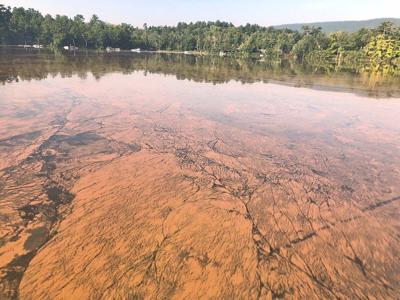STOCKBRIDGE — The rust-colored algae bloom infestation observed this week on portions of Stockbridge Bowl has prompted the Tri Town Health Department to issue a public health advisory emphasizing that swimming and boating is not advisable until the state conducts additional testing early next week.
"Drinking of lake water is extremely discouraged," the department's advisory states. Tri Town Health covers Stockbridge, Lenox and Lee.
The advisory was posted Friday afternoon at the town beach and the boat launch ramp on Interlaken Road (Route 183). An automated phone call from Town Administrator Danielle Fillio went out to residents late Friday.
"Any swimming or boating done at this time is at your own risk," Tri Town Health cautioned, "Once we know more information, we will further communicate to the public the status and results of the algae testing."
In her message, Fillio said that the town is in communication with the State Department of Public Health and other agencies, which will sample the water Tuesday to further investigate and identify the algae bloom. Results of the testing will be available Wednesday morning, said Jim Wilusz, executive director of Tri Town Health.
Fillio described the DPH recommendation as precautionary advice "not to swim and to limit water contact with the areas where the algae is located, until laboratory testing results are obtained. The discoloration of water and lack of clarity presents swimmer safety issues."
On Wednesday, the state Department of Environmental Protection's emergency response team took photos of the algae bloom but could not obtain a sample.
The state Department of Public Health and the Department of Conservation and Recreation determined, based on photos, that the discoloration was not cyanobacteria (blue-green algae) associated with typical toxic blooms. The agencies advised swimmers to keep away from visible scums and discouraged drinking of any lake water.
FIllio reported Wednesday, based on information from Tri Town Health, that weekly water testing at the beach conducted on Monday came back normal, with no elevated levels of E. coli or bacteria. She also said that DCR and Tri Town Health officials blamed the discoloration on excessive rain and heat.
Scientists have noted an unusual number of algae blooms this summer on New York's Finger Lakes, Lakes Erie and Superior and along parts of Florida's Gulf Coast, intensified by warmer water, heat waves and extreme weather connected with climate change. They also cite human activity, including farm and phosphorus runoff, leakage from sewer systems and other pollution.


